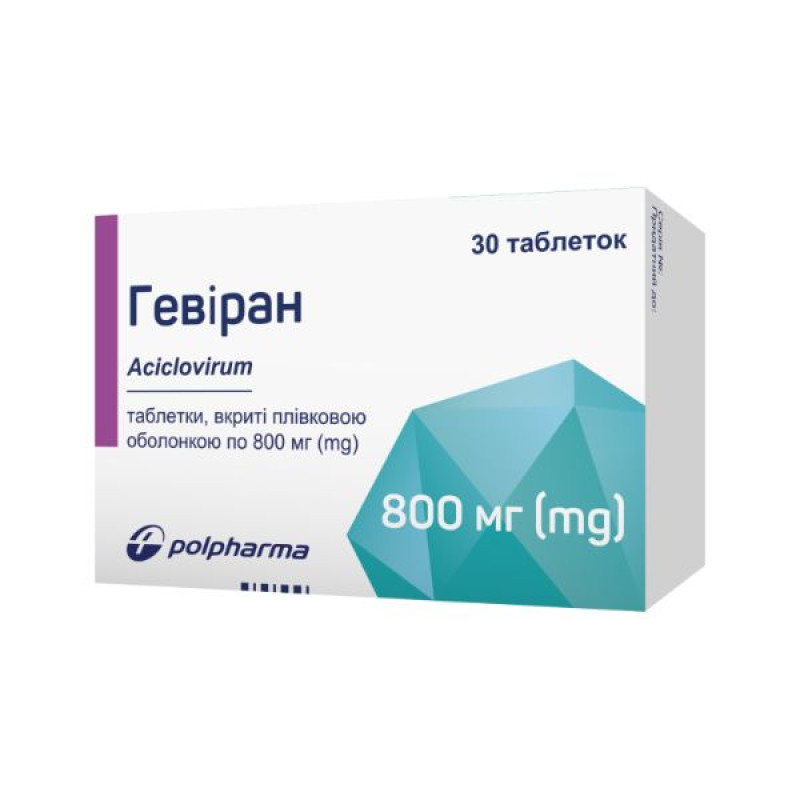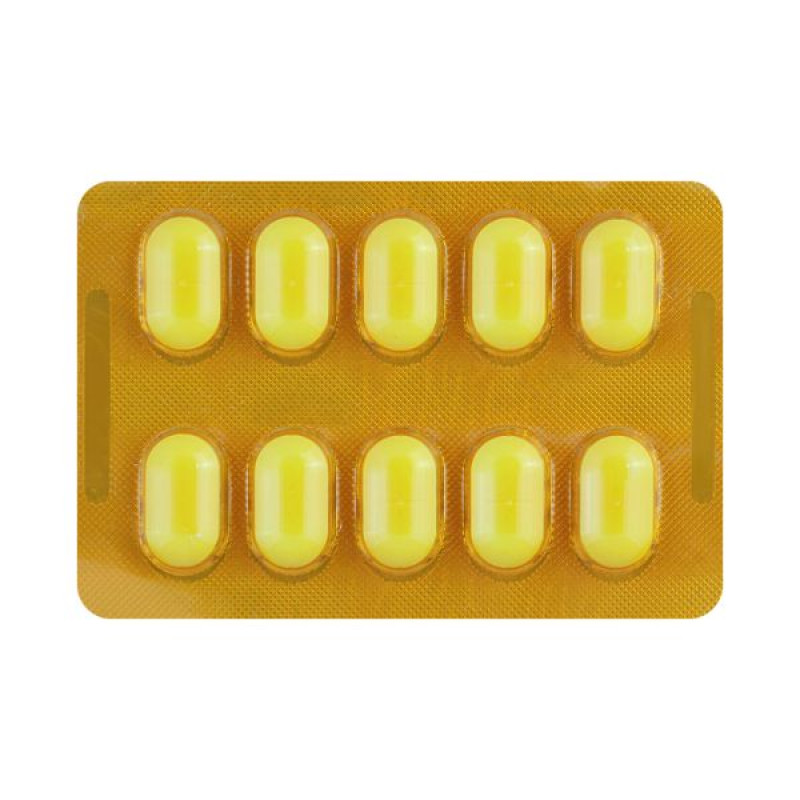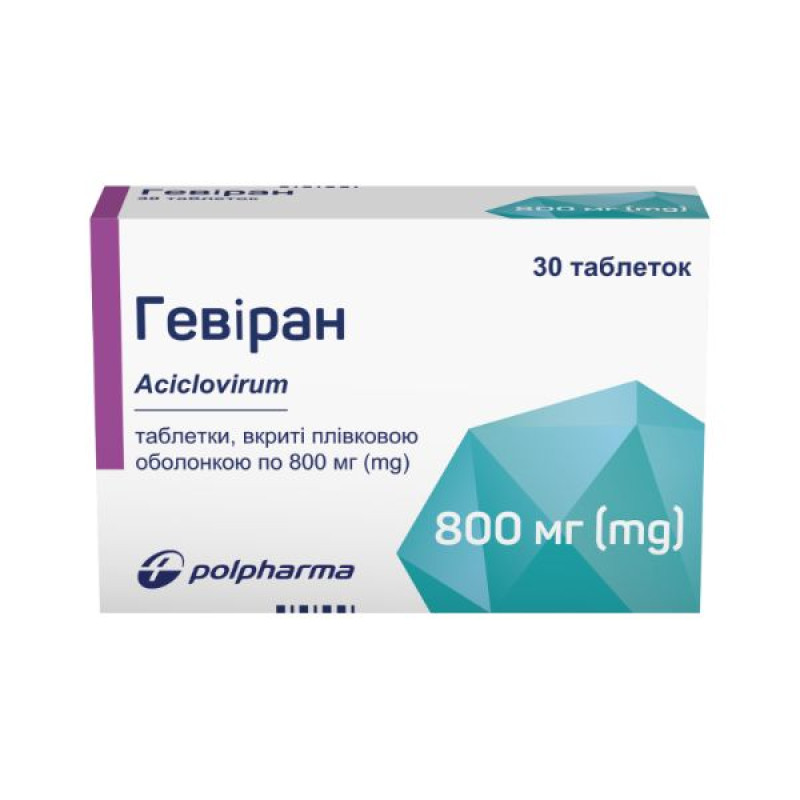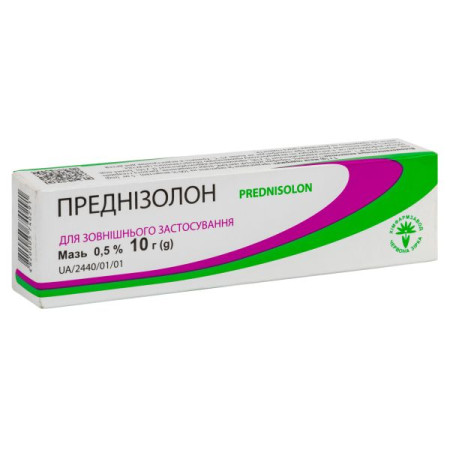Geviran film-coated tablets 800 mg blister No. 30

Pharmacological properties
Pharmacodynamics. Acyclovir is a synthetic analogue of a purine nucleoside, which in vitro and in vivo inhibits the replication of human pathogenic herpes viruses: herpes simplex (HSV) types I and II and varicella zoster virus (VZV).
The action of acyclovir on inhibition of replication of these viruses is very selective. In uninfected cells, acyclovir is not used as a substrate for endogenous thymidine kinase (TK), so the toxic effect on mammalian cells is insignificant. However, TK of viral origin, encoded by HSV and VZV viruses, phosphorylates acyclovir to a monophosphate derivative (nucleoside analog), which is then phosphorylated with the participation of cellular enzymes to di- and triphosphatacyclovir. Triphosphatacyclovir is a substrate for viral DNA polymerase, which incorporates it into viral DNA, thus completing the synthesis of the viral DNA chain and suppressing its replication.
Prolonged use of acyclovir or repeated courses of treatment in patients with severe immunodeficiency may cause the emergence of virus strains resistant to acyclovir. Most isolated strains with reduced sensitivity show TC deficiency, but strains with altered viral TC or DNA polymerase have also been described. In vitro studies have also revealed the ability of HSV strains to form with reduced sensitivity. The relationship between the sensitivity of the herpes virus to acyclovir, determined in vitro, and the clinical response to treatment is unknown.
Pharmacokinetics. Acyclovir is partially absorbed from the gastrointestinal tract. At steady state, the mean maximum concentration (C SSmax) after administration of the drug at a dose of 200 mg every 4 hours is 3.1 μmol/l (0.7 μg/ml), and the corresponding minimum concentration (C SSmin) is 1.8 μmol/l (0.4 μg/ml). After administration of the drug at doses of 400 and 800 mg every 4 hours, C SSmax is 5.3 μmol/l (1.2 μg/ml) and 8 μmol/l (1.8 μg/ml), respectively, and C SSmin is 2.7 μmol/l (0.6 μg/ml) and 4 μmol/l (0.9 μg/ml).
After administration of acyclovir to adults, T ½ from blood plasma is approximately 2.9 hours. Most of it is excreted in the urine unchanged. Renal clearance of acyclovir is significantly higher than creatinine clearance, which indicates the participation of tubular secretion in the presence of filtration in the excretion of the drug in the urine. The most significant metabolite of acyclovir is 9-carboxymethoxymethylguanine, which is excreted in the urine in an amount of about 10-15% of the administered dose.
Taking 1 g of probenecid 60 minutes before acyclovir administration prolongs T½ of acyclovir by 18%, and AUC in blood plasma increases by 40%.
In adults, Cmax after a 1-hour infusion of acyclovir at doses of 2.5, 5, and 10 mg/kg body weight was 22.7 μmol (5.1 μg/ml), 43.6 μmol (9.8 μg/ml), and 92 μmol (20.7 μg/ml), respectively. Cmin after 7 hours was 2.2 μmol (0.5 μg/ml), 3.1 μmol (0.7 μg/ml), and 10.2 μmol (2.3 μg/ml). When children aged 1 year and older were given a dose of 250 mg/m2 instead of a dose of 5 mg/kg body weight, and a dose of 500 mg/m2 instead of a dose of 10 mg/kg body weight, Cmax and Cmin values were similar to those observed in adults. In neonates and infants under 3 months of age, who were administered acyclovir at doses of 10 mg/kg body weight every 8 hours by 1-hour infusion, C SSmax was 61.2 μmol (13.8 μg/ml), and C SSmin was 10.1 μmol (2.3 μg/ml).
T ½ of the drug from blood plasma is 3.8 hours.
In elderly patients, the total clearance of acyclovir decreases with creatinine clearance, although the change in T ½ from plasma is insignificant.
In patients with chronic renal failure, T ½ of acyclovir is 19.5 hours. T ½ of acyclovir during hemodialysis is 5.7 hours. The concentration of the drug in blood plasma during dialysis is reduced by 60%.
The concentration of acyclovir in the cerebrospinal fluid is about 50% of the level in blood plasma. The binding of acyclovir to blood plasma proteins is insignificant (9-33%), so competitive displacement of acyclovir from binding sites by other drugs has not been observed.
Indication
Treatment of viral infections of the skin and mucous membranes caused by the herpes simplex virus, including primary and recurrent genital herpes; prevention of recurrence of infections caused by the herpes simplex virus in patients with normal immunity; prevention of infections caused by the herpes simplex virus in patients with immunodeficiency; treatment of infections caused by the vzv virus (chickenpox and herpes zoster);Application
The tablet should be taken whole with water. When using high doses of acyclovir, adequate hydration should be maintained.
Adults. Treatment of infections caused by the herpes simplex virus (HSV). For the treatment of infections caused by the herpes simplex virus, Geviran tablets should be taken 200 mg 5 times a day (approximately every 4 hours) with a break at night. The drug is taken for 5 days, with severe primary infections the course of treatment can be extended to 10 days.
In patients with reduced immunity (for example, after bone marrow transplantation) or impaired absorption in the gastrointestinal tract, the dose may be doubled to 400 mg or an appropriate dose of the drug for intravenous administration may be used.
Acyclovir should be started immediately after diagnosis. In recurrent infections, it is very important to start taking the drug in the prodromal period or immediately after the first signs of illness appear.
Prevention of recurrence of herpes simplex (HSV) in patients with normal immunity
For many patients, the effective use of the drug is 400 mg 2 times a day every 12 hours.
Treatment will be effective even after reducing the dose of Geviran tablets to 200 mg, which is taken 3 times a day with an interval of 8 hours or even 2 times a day with an interval of 12 hours. In some patients, the response to the prophylactic use of the drug appears after using a daily dose of 800 mg.
The drug should be used intermittently every 6-12 months, observing possible changes in the course of the disease.
Prevention of infections caused by the herpes simplex virus. For the prevention of infections caused by the herpes simplex virus, in immunocompromised patients, 200 mg tablets should be taken 4 times a day every 6 hours. In patients with significant immunodeficiency (for example, after bone marrow transplantation) or in patients with reduced intestinal absorption, the dose can be doubled to 400 mg or the appropriate dose for intravenous administration can be used.
The duration of prophylactic use is determined by the doctor depending on the course of the disease and the individual sensitivity of the patient.
Treatment of infections caused by the varicella zoster virus and herpes zoster. The drug should be taken at 800 mg 5 times a day (approximately every 4 hours) with a break at night. The duration of treatment is 7 days.
In patients with reduced immunity (for example, after bone marrow transplantation) or absorption disorders in the gastrointestinal tract, intravenous administration of the drug is possible.
Treatment should be started immediately, as soon as the diagnosis is made. Treatment for chickenpox and herpes zoster is effective if the drug is started immediately after the first rash appears.
children
Treatment of infections caused by the herpes simplex virus (HSV). Children aged 2 years and older should be given the same dose as adults.
Treatment of infections caused by the varicella virus. Children aged 2 to 6 years: 400 mg 4 times a day.
Children over 6 years of age: 800 mg 4 times a day.
The dose can be determined more precisely at the rate of 20 mg/kg body weight (up to a maximum dose of 800 mg) 4 times a day. The duration of treatment is 5 days.
There are no data on the prevention of recurrence of infections caused by the herpes simplex virus and herpes zoster in children with normal immunity.
Elderly patients: In elderly patients, renal impairment should be considered and the dose adjusted accordingly. The level of hydration should be monitored.
Patients with renal impairment: Acyclovir should be used with caution in patients with renal impairment and adequate hydration should be maintained.
In the treatment of infections caused by the herpes simplex virus or the prevention of viral infection in patients with moderate or severe renal insufficiency, the use of recommended oral doses does not cause the accumulation of acyclovir in the body in concentrations above those considered safe for administration of the drug. However, in patients with severe renal insufficiency (creatinine clearance 10 ml / min) it is recommended to set the dose to 200 mg 2 times a day every 12 hours.
In the treatment of infections caused by the varicella and herpes zoster viruses, in patients with moderate renal insufficiency (creatinine clearance 10-25 ml/min) it is recommended to set the dose to 800 mg 3 times a day every 8 hours, and in patients with severe renal insufficiency (creatinine clearance 10 ml/min) it is recommended to reduce the dose to 800 mg 2 times a day every 12 hours.
Contraindication
Hypersensitivity to acyclovir, valacyclovir or other components of the drug.
Side effects
From the blood and lymphatic system: anemia, decreased white blood cell count, thrombocytopenia.
Immune system disorders: anaphylactic reactions.
From the psyche and nervous system: headache, dizziness; very rarely - agitation, confusion, tremor, ataxia, dysarthria, hallucinations, psychotic symptoms, convulsions, drowsiness, encephalopathy, coma.
These symptoms are usually transient and occur mainly in patients with impaired renal function or other predisposing factors.
Respiratory, thoracic and mediastinal disorders: shortness of breath.
Gastrointestinal: nausea, vomiting, diarrhea, abdominal pain.
From the liver and biliary tract: temporary increase in bilirubin levels and increased activity of hepatic transaminases in the blood, hepatitis, jaundice.
Skin: itching, rash (also increased sensitivity to light), urticaria, generalized alopecia. Since the cause of generalized alopecia can be many diseases and the use of various drugs, its occurrence when taking acyclovir is not determined, vasomotor edema.
Renal: increased levels of creatinine and urea in blood plasma, acute renal failure, pain in the kidney area.
Pain in the kidney area may be associated with kidney failure.
The patient's hydration status should be monitored. Renal impairment usually resolves rapidly after fluid repletion and/or dose reduction or discontinuation of the drug. In exceptional cases, acute renal failure may occur.
General disorders and administration site conditions: fatigue, fever.
Acyclovir is excreted from the body in the urine, so in patients with renal failure, the dose of the drug should be reduced. In elderly people, possible impaired renal function should be taken into account; in such patients, the possibility of reducing the dose of the drug should be taken into account. Elderly people and patients with renal failure are at increased risk of developing side effects from the nervous system, so the condition of patients in this category should be carefully monitored. The currently known symptoms usually disappeared after discontinuation of the drug.
Use during pregnancy and lactation. In post-marketing studies of medicinal products containing acyclovir, cases of acyclovir use in pregnant women and the appearance of disorders in them have been reported. According to the results of these studies, an increase in the frequency of developmental anomalies in newborns whose mothers took acyclovir was not detected compared with the general population. Acyclovir should be prescribed to pregnant women only when the expected benefit to the mother outweighs the potential risk to the fetus.
When administered orally at a dose of 200 mg 5 times a day, acyclovir penetrates into breast milk in concentrations that are 0.6-4.1% of acyclovir in blood plasma. Potentially, a child fed with such breast milk can absorb acyclovir at a dose of 0.3 mg/kg of body weight per day.
The drug should be prescribed to women during breastfeeding with extreme caution, taking into account the risk to the child.
Children. The drug in this dosage form is not used in children under 2 years of age.
Ability to influence the reaction rate when driving vehicles or working with other mechanisms. When deciding on the possibility of driving vehicles and other mechanisms, the patient's clinical status and the profile of adverse reactions should be taken into account. Studies on the effect of the drug Geviran on the ability to drive vehicles and work with mechanisms have not been conducted. Given the possible occurrence of side effects, caution should be exercised when driving vehicles and working with other mechanisms.
Interactions
No clinically significant drug interactions were identified.
Acyclovir is excreted mainly unchanged by active renal tubular secretion. Concomitant administration of drugs that are metabolized in the body in the same way may increase plasma concentrations of acyclovir. Probenecid and cimetidine increase the AUC of acyclovir and reduce its renal clearance. A similar increase in plasma levels of acyclovir and its inactive metabolite, mycophenolate mofetil, an immunosuppressant used in transplant patients, has been observed with concomitant administration of these drugs. However, given the wide therapeutic range of acyclovir, there is no need to change the dose.
Overdose
Symptoms: Acyclovir is partially absorbed from the gastrointestinal tract. A single dose of up to 20 g of acyclovir usually does not cause symptoms of poisoning. In isolated cases of overdose of acyclovir for oral administration for 7 days, symptoms from the gastrointestinal tract (nausea, vomiting) and nervous system (headache, confusion) appeared.
Neurological symptoms such as confusion, hallucinations, agitation, seizures, and coma have also been described in overdose with the injectable form of the drug.
Treatment: The patient should be observed for symptoms of poisoning. Treatment is symptomatic. Hemodialysis accelerates the removal of acyclovir from the blood and can be used in case of symptoms of overdose.
Storage conditions
In a dry place protected from light at a temperature not exceeding 25 °C.
There are no reviews for this product.
There are no reviews for this product, be the first to leave your review.
No questions about this product, be the first and ask your question.











